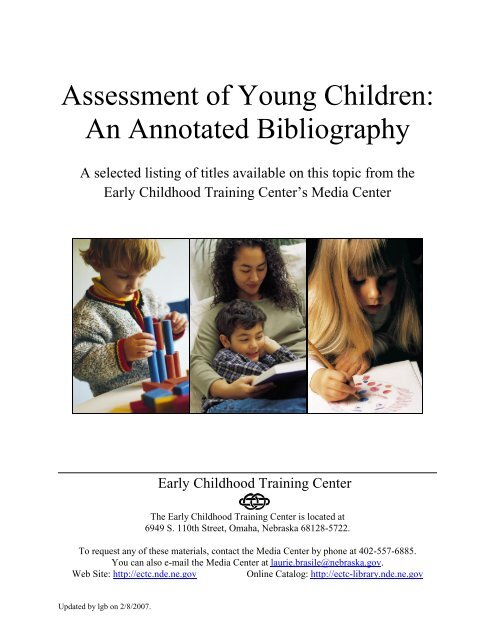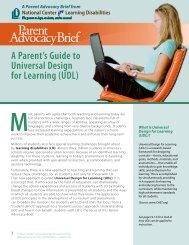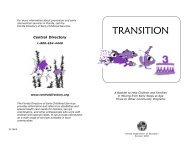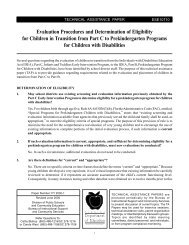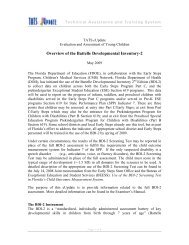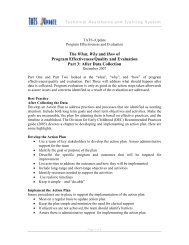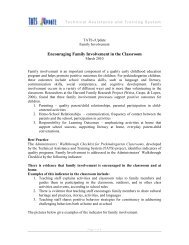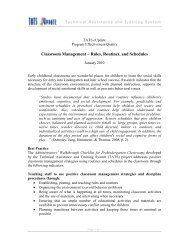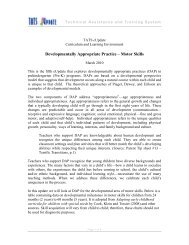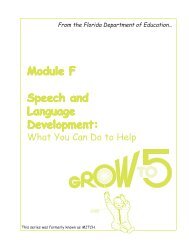Assessment of Young Children: An Annotated Bibliography - TATS
Assessment of Young Children: An Annotated Bibliography - TATS
Assessment of Young Children: An Annotated Bibliography - TATS
Create successful ePaper yourself
Turn your PDF publications into a flip-book with our unique Google optimized e-Paper software.
<strong>Assessment</strong> <strong>of</strong> <strong>Young</strong> <strong>Children</strong>:<br />
<strong>An</strong> <strong>An</strong>notated <strong>Bibliography</strong><br />
A selected listing <strong>of</strong> titles available on this topic from the<br />
Early Childhood Training Center’s Media Center<br />
Early Childhood Training Center<br />
The Early Childhood Training Center is located at<br />
6949 S. 110th Street, Omaha, Nebraska 68128-5722.<br />
To request any <strong>of</strong> these materials, contact the Media Center by phone at 402-557-6885.<br />
You can also e-mail the Media Center at laurie.brasile@nebraska.gov.<br />
Web Site: http://ectc.nde.ne.gov<br />
Online Catalog: http://ectc-library.nde.ne.gov<br />
Updated by lgb on 2/8/2007.
Books<br />
Achievement Testing in the Early Grades: The Games Grown-Ups Play. Constance Kamii, Editor.<br />
(1990). Washington, DC: National Association for the Education <strong>of</strong> <strong>Young</strong> <strong>Children</strong>. This book takes a<br />
stand on stopping standardized achievement testing in grades K-2. It explores answers to such questions<br />
as: Should promotion and retention decisions be based on standardized tests? Through what other ways<br />
can reading and math progress be measured? Do standardized tests really measure what educators need to<br />
know to teach better? The goal <strong>of</strong> the book is to stimulate thinking and discussion about standardized test<br />
practices in the early grades.<br />
All About the ECERS-R: A Detailed Guide. Debby Cryer. (2004). New York: Teachers College Press.<br />
All About the ECERS-R is a resource guide to be used with the Early Childhood Environment Rating<br />
Scale, revised edition. It gives information on why each item is important, what is needed to meet the<br />
requirements for all items, and how to score. Color photographs taken in child care settings are used to<br />
illustrate the text.<br />
All About the ITERS-R: A Detailed Guide. Debby Cryer. (2004). New York: Teachers College Press.<br />
This resource guide should be used with the Infant/Toddler Environment Rating Scale-revised edition. It<br />
explains why each item is important, what is needed to meet the requirements for all items, and how to<br />
score. Over 800 color photographs taken in child care settings are presenting in this text.<br />
Alternative Approaches to Assessing <strong>Young</strong> <strong>Children</strong>. <strong>An</strong>gela Losardo. (2001). Baltimore, MD:<br />
Brookes. Pr<strong>of</strong>essionals who work with children from birth to age eight will find in-depth examinations <strong>of</strong><br />
six alternative assessment models: naturalistic, focused, performance, portfolio, dynamic, and<br />
curriculum-based language. For each model, readers will receive a description <strong>of</strong> the approach,<br />
advantages and limitations, specific guidelines for implementation, vignettes showing the models in<br />
action, photocopiable blank assessment forms, sample data collection forms, and suggestions for working<br />
in inclusive environments.<br />
Assessing the State <strong>of</strong> State <strong>Assessment</strong>s. Donna Nalley, (Ed.). (2003). Greensboro , NC: Regional<br />
Educational Laboratory at SERVE. This document is a collection <strong>of</strong> papers that reflect discussions that<br />
took place during a symposium on readiness assessment systems and the author's collective experience<br />
working on issues related to wide-scale early childhood assessment systems.<br />
<strong>Assessment</strong>, Evaluation, and Programming System for Infants and <strong>Children</strong>, AEPS Measurement<br />
for Birth to Three Years. Volume 1, 2nd Edition. Diane Bricker. (2002). Baltimore, MD: Paul H.<br />
Brookes Publishing Co., Inc. This volume includes an overview <strong>of</strong> the purpose <strong>of</strong> the AEPS, the AEPS<br />
test manual, and family participation.<br />
<strong>Assessment</strong>, Evaluation, and Programming System for Infants and <strong>Children</strong>, Volume 2, AEPS<br />
Curriculum for Birth to Three Years, 2nd Edition. Diane Bricker. (2002). Baltimore, MD: Paul<br />
Brookes Publishing. This volume shows ways to enhance future intervention efforts with young children<br />
and to make positive differences in their lives. Domains addressed include: fine motor; gross motor,<br />
adaptive, cognitive, social-communication, and social. This volume includes a family interest survey and<br />
an administration guide section.<br />
<strong>Assessment</strong>, Evaluation, and Programming System for Infants and <strong>Children</strong>, Volume 3, AEPS<br />
Measurement for Three to Six Years, 2nd Edition. Diane Bricker. (2002). Baltimore, MD: Paul<br />
Brookes Publishing Co., Inc. This volume includes sections on understanding the assessment, the test<br />
manual and domains therein, and family participation. A variety <strong>of</strong> forms are included available for<br />
copying.
<strong>Assessment</strong>, Evaluation, and Programming System Curriculum for Three to Six Years. Volume 4,<br />
2nd Edition. Diane Bricker. (2002). Baltimore, MD: Paul H. Brookes Publishing Co., Inc. This volume<br />
introduces the AEPS curriculum, defines how the program is divided into domains <strong>of</strong> assessment,<br />
evaluation, programming, curriculum. Includes the AEPS curriculum administration guide, and planned<br />
activities.<br />
<strong>Assessment</strong>: Gathering Meaningful Information. Michaelene Ostrosky. (2002). Missoula, MT:<br />
Division for Early Childhood <strong>of</strong> the Council for Exceptional <strong>Children</strong>. Articles in this monograph<br />
examine the impact <strong>of</strong> environment on information gathering, the value <strong>of</strong> positive interventions to build<br />
useful skills, dynamic assessment as a gauge <strong>of</strong> future development, and how cultural and linguistic<br />
differences shape assessment strategies.<br />
<strong>Assessment</strong> <strong>of</strong> Practices in Early Elementary Classrooms (APEEC). Mary Louise Hemmeter. New<br />
York: Teachers College Press. 2001. APEEC is the first measurement scale designed to evaluate the use<br />
<strong>of</strong> developmentally appropriate practices in the early elementary classroom (K-3). Developed for<br />
classrooms serving both children with and without disabilities, the APEEC can be used by administrators<br />
and researchers to evaluate the degree <strong>of</strong> developmental appropriateness in inclusive and general<br />
education classrooms. It can also be used by teachers as a self-assessment tool. The book includes a score<br />
sheet which can be photocopied for use in rating classrooms.<br />
Basics <strong>of</strong> <strong>Assessment</strong>: A Primer for Early Childhood Educators. Oralie McAfee. (2004).<br />
Washington, DC: National Association for the Education <strong>of</strong> <strong>Young</strong> <strong>Children</strong>. <strong>Assessment</strong> <strong>of</strong> children's<br />
abilities and knowledge, their approaches to learning, and their strengths, needs, and interests is expected<br />
in most early childhood programs. However, many early childhood educators are unsure <strong>of</strong> how to assess<br />
young children's development and learning. This straightforward booklet will help increase<br />
understanding <strong>of</strong> child assessment, including its specialized and <strong>of</strong>ten confusing vocabulary. Focusing on<br />
children's development and learning, the authors provide an overview <strong>of</strong> basic assessment concepts.<br />
Speaking a shared language <strong>of</strong> assessment will help early childhood pr<strong>of</strong>essionals communicate better<br />
with other teachers, specialists, administrators, and parents.<br />
Beyond the Bell: Start-Up Guide for Afterschool Programs. (2005). Learning Point Associates.<br />
Naperville, IL: Author. The Beyond the Bell Start-Up Guide is a step-by-step handbook for getting a<br />
program <strong>of</strong>f the ground. From obtaining funding to conducting a needs assessment, to taking your first<br />
steps as a new program, the guide provides all the resources, examples, and tips you need. Find out how<br />
to find funding sources, how to write a proposal, what you need to know about your community before<br />
you start, and more.<br />
But Are They Learning…A Commonsense Parents’ Guide to <strong>Assessment</strong> and Grading in Schools.<br />
Richard Stiggins. (1997). Portland, OR: <strong>Assessment</strong> Training Institute. Here's a book designed to speak<br />
directly to parents, providing them with the background they need to understand assessment issues.<br />
They'll learn why assessment is so important, what quality assessment looks like, how assessment works<br />
in the classroom, and how parents can work in partnership with teachers to help their children succeed.<br />
Capturing ALL <strong>of</strong> the Reader Through the Reading <strong>Assessment</strong> System. Rachel Billmeyer. (2001).<br />
Omaha, NE: Dayspring Printing. The Reading <strong>Assessment</strong> System presents a new view <strong>of</strong> assessing<br />
readers. The intent <strong>of</strong> this innovative approach is to develop strategic readers involved in the assessment<br />
process. Through the Reading <strong>Assessment</strong> System students can gain confidence in themselves as readers<br />
and learners.
The Creative Curriculum for Preschool, 4th Edition. Diane Trister Dodge. (2002). Washington, DC:<br />
Teaching Strategies. The Creative Curriculum approach balances both teacher-directed and childinitiated<br />
learning, with an emphasis on responding to children's learning styles and building on their<br />
strengths and interests. New to the 4th Edition: child development and learning theory and how it's<br />
applied throughout the curriculum; goals and objectives linked directly to a valid and reliable assessment<br />
instrument; the addition <strong>of</strong> discovery areas as a new interest area; strategies for meeting the needs <strong>of</strong><br />
second language learners and children with disabilities; specific guidance on the teacher's role in<br />
teaching content in literacy, math, science, social studies, the arts, and technology; a wide range <strong>of</strong><br />
instructional strategies from child-initiated to teacher-directed learning; and guidance on building social<br />
competence in children, teaching social problem-solving skills, and responding to challenging behavior.<br />
Creative Curriculum for Preschool: Implementation Checklist. Diane Trister Dodge. (2003).<br />
Washington, DC: Teaching Strategies. The Creative Curriculum for Preschool Implementation Checklist<br />
is designed to assess how well the Curriculum is being implemented as intended. The Implementation<br />
Checklist may be used alone or with its related forms: the Classroom Pr<strong>of</strong>ile and the Progress and<br />
Planning Form. A copy <strong>of</strong> each <strong>of</strong> these forms is included with the Checklist.<br />
Creative Curriculum for Infants, Toddlers, and Twos: Developmental Continuum <strong>Assessment</strong><br />
Tool. Diane Trister Dodge. (2006). Washington, DC: Teaching Strategies. The Creative Curriculum for<br />
Infants, Toddlers, and Twos helps teachers appreciate and find joy in the everyday discoveries that<br />
delight a child. It is a comprehensive curriculum that helps teachers create the very best program for<br />
children under age three. This second edition retains its focus on building relationships, responsive care,<br />
and routines and experiences, but updates the curriculum in many important ways. It links curriculum and<br />
assessment, addressed language and literacy, math, and science, it meets the needs <strong>of</strong> dual language<br />
learners and children with disabilities, it highlights the research and theory on which the curriculum is<br />
based, and includes practical advice about creating a responsive environment and individualized care.<br />
Currículo Creativo Para Educación Preescolar (Creative Curriculum for Preschoolers). Dodge, Diane<br />
Trister. (2004). Washington, DC: Enseñando con estrategia. Guía al maestro a través del proceso de crear<br />
un ambiente desarrollado apropiado para niños pre-escolares. Es basado en la creencia, confirmado por<br />
muchos estudios, que los niños aprenden mejor a través de sus relaciones sociales y físicas en sus vidas.<br />
DEC Recommended Practices: Program <strong>Assessment</strong>. Mary Louise Hemmeter. (2001). Denver, CO:<br />
Division for Early Childhood <strong>of</strong> the Council for Exceptional <strong>Children</strong>. A companion to the DEC<br />
Recommended Practices in Early Intervention/ Early Childhood Special Education, this assessment is<br />
designed to assist in assessing and improving the quality <strong>of</strong> services provided to young children with<br />
disabilities and their families. The assessment is appropriate for Head Start, child care, public school, or<br />
other early childhood programs that are using developmentally appropriate classrooms and curricula.<br />
Developmental Screening in Early Childhood: A Guide. Samuel Meisels. (2005). Washington, DC:<br />
National Association for the Education <strong>of</strong> <strong>Young</strong> <strong>Children</strong>. Sound developmental screening identifies<br />
those children who should receive more extensive assessment to determine whether they need additional<br />
support for learning. This book covers the basics <strong>of</strong> selecting an appropriate instrument and setting up a<br />
screening program. This fifth edition reviews six widely-used general screening instruments, discusses<br />
screening specific areas <strong>of</strong> development, reviews five screens for social/emotional or behavior concerns,<br />
and includes an annotated bibliography <strong>of</strong> research and resources.<br />
Early Childhood Environment Rating Scale, revised. Thelma Harms; Richard M. Clifford. (2005).<br />
New York: Teachers College Press. The rating scale covers personal care routines, furnishings and<br />
displays for children, language and reasoning experiences, fine and gross motor activities, creative<br />
activities, social development and adult needs. Includes rating scale, a section on how to train observers,<br />
and research on validity and reliability.
Early Screening Inventory, Revised ( ESI -R). Samuel J Meisels. (1997). <strong>An</strong>n Arbor, MI: Rebus. The<br />
ESI -R is a brief developmental screening instrument that is individually administered to children from<br />
three to six years <strong>of</strong> age. It is designed to identify children who may need special educational services in<br />
order to perform successfully in school. A second element <strong>of</strong> the instrument is the parent questionnaire.<br />
Family Day Care Rating Scale. Thelma Harms and Richard M.Clifford. (1989). New York: Teachers<br />
College Press. Written especially for family day care providers, this instrument assesses space and<br />
furnishings, basic care, language and reasoning, learning activities, social development, adult needs and<br />
special section on exceptional children. Included are instructions on how to use the scale, rating scale<br />
items and notes to help clarify.<br />
First Grade Takes a Test. Miriam Cohen. (1980). New York: Bantam Doubleday Dell Books for <strong>Young</strong><br />
Readers. This children's book talks about taking tests and shows that tests don’t always measure what<br />
they intend to.<br />
Focused Early Learning. Gay Gronlund. (2003). St. Paul, MN: Redleaf Press. Focused Early Learning is<br />
a detailed framework that enables teachers to plan, record, reflect on, and adjust multiple curriculum<br />
approaches.<br />
Focused Portfolios: A Complete <strong>Assessment</strong> for the <strong>Young</strong> Child. Gaye Gronlund. (2001). St. Paul,<br />
MN: Redleaf Press. Focused Portfolios <strong>of</strong>fers an innovative method to accurately document children's<br />
growth and development and plan curriculum accordingly. This system asks teachers to observe children<br />
in the natural context <strong>of</strong> teaching or caregiving.<br />
Home Visiting, 2nd Edition. Barbara Hanna Wasik and Donna Bryant. (2001). Thousand Oaks, CA:<br />
Sage. Prevention and intervention programs delivered via home visiting can now be found across all<br />
health, education, and social sciences. In this second edition, the authors have updated their information<br />
about current theories <strong>of</strong> family development and interaction and adult problem solving, and related those<br />
to the day-to-day practice <strong>of</strong> home visiting. Additionally, they provide new information on assessment<br />
instruments and the personal safety <strong>of</strong> the home visitor.<br />
Innovations: The Comprehensive Toddler Curriculum Teacher's Guide. Kay Albrecht. (2001).<br />
Beltsville, MD: Gryphon House. Innovations: The Comprehensive Toddler Curriculum, Teacher's Guide<br />
provides over 40 hours <strong>of</strong> pr<strong>of</strong>essional development for teachers. It is designed to be completed by an<br />
individual teacher with the support <strong>of</strong> a mentor, trainer, director, or principal.<br />
LINKing <strong>Assessment</strong> and Early Intervention: <strong>An</strong> Authentic Curriculum-Based Approach. Stephen<br />
J. Bagnato, John T. Neisworth and Susan M. Munson. (1997). Baltimore: Brookes. The authors identify<br />
authenticity, collaboration, convergence, equity, sensitivity, and congruence as the best properties <strong>of</strong><br />
well-known assessment curriculum models, and apply them to more than 50 different curriculumembedded<br />
and compatible assessment and intervention systems, rating and analyzing each.<br />
Linking Teacher Evaluation and Student Learning. Pamela D. Tucker. (2005). Alexandria, VA:<br />
ASCD. If you've ever doubted that it was fair or effective to judge teachers on the basis <strong>of</strong> student test<br />
scores alone, then here's a book that will introduce you to better ways to use measures <strong>of</strong> student<br />
achievement in your te ach er assessment system. The authors take you to four schools to show you how<br />
to link teacher performance to student learning by using four objective measurements.
New Visions for the Developmental <strong>Assessment</strong> <strong>of</strong> Infants and <strong>Young</strong> <strong>Children</strong>. Samuel J Meisels<br />
and Emily Fenichel. (1996). Washington, DC: National Center for Infants, Toddlers, and Families. This<br />
book presents ideas for assessing infants and children, parents’ perspectives on sharing responsibility and<br />
commitment, effect <strong>of</strong> children's backgrounds and interviewing techniques, and approaches to and<br />
philosophies <strong>of</strong> assessing infants and children. A zero-to-three mission statement and a value-based<br />
model <strong>of</strong> infant and toddler assessment are included.<br />
Observation: The Primary Tool in <strong>Assessment</strong>—To See Each Child with Wisdom, Humor, and<br />
Heart. Exchange Press. Redmond, WA: Author. This training kit is designed to introduce teachers to<br />
using observation as the primary tool in gathering evidence <strong>of</strong> developmental growth and to develop<br />
skills in doing so. It contains: expected training outcomes, preparation instructions, raining strategies and<br />
tips, implementation steps, follow-up activities for teachers, follow-up activities for<br />
administrators/directors, a learning assessment, a training evaluation/further needs assessment, a resource<br />
list, and the articles "Observation: The Primary Tool in <strong>Assessment</strong>" by Kay Stritzel Rencken and "To<br />
See Each Child with Wisdom, Humor, and Heart" by Sally Cartwright<br />
Observation and Participation in Early Childhood Settings: A Practicum Guide, Birth through<br />
Age Five. Jean Billman, and Janice A. Sherman, (1997). Needham Heights, ME: Allyn & Bacon. The<br />
book is designed to guide readers' participation with children <strong>of</strong> different age groups in a variety <strong>of</strong> early<br />
childhood settings. The book encourages readers to interact with children as they learn more about<br />
development by carrying out the activities outlined in each chapter.<br />
Oral Language and Early Literacy in Preschool: Talking, Reading, and Writing. Kathleen A.<br />
Roskos. (2004). Newark, DE: International Reading Association. The authors have collaborated on a<br />
simple model for joining oral language and early literacy that will prepare children for life both in and<br />
out <strong>of</strong> school. Chapters <strong>of</strong>fer current research, planning and assessment suggestions, and instructional<br />
approaches to help you make informed decisions about what oral language skills children need to learn,<br />
what kinds <strong>of</strong> language and literacy experiences to provide, what to look for in programs and materials,<br />
and whether children are making progress in their use <strong>of</strong> language.<br />
Pathways to Competence. Sarah Landy. (2002). Baltimore: Brookes. Readers will explore nine social<br />
and emotional domains <strong>of</strong> children from birth to six years: a sense <strong>of</strong> body self, attachment to caregivers,<br />
play and imagination, language and communication, self-esteem, morality and conscience, emotion<br />
regulation, concentration and problem solving, and empathy and pro-social behavior. For each domain,<br />
readers get an entire chapter that includes: a breakdown <strong>of</strong> major theories and descriptions <strong>of</strong> key<br />
research findings; a detailed, age-specific description <strong>of</strong> how young children develop in each domain;<br />
easy-to- implement suggestions pr<strong>of</strong>essionals can use to help caregivers — and help themselves —<br />
interact with children and guide their development; tips to help pr<strong>of</strong>essionals interact positively with<br />
caregivers; group exercises and activities that help caregivers enhance development, both in themselves<br />
and in their children; discussion questions for pre-service and in-service pr<strong>of</strong>essionals and suggestions<br />
for further reading; and an appendix <strong>of</strong> assessment tools that will help measure the child's progress.<br />
The Portfolio and Its Use: A Road Map for <strong>Assessment</strong>. Sharon MacDonald. (1997). Little Rock, AK:<br />
Southern Early Childhood Association. This book includes chapters on how young children learn,<br />
advantages <strong>of</strong> portfolio assessment, building portfolios and anecdotal records, and using portfolios.<br />
Practice with Student-Involved Classroom <strong>Assessment</strong>. Judith A. Arter. (2001). Portland, OR:<br />
<strong>Assessment</strong> Training Institute. This workbook was written to accompany Rick Stiggins’ book, Student-<br />
Involved Classroom <strong>Assessment</strong>, 3rd Edition. It <strong>of</strong>fers guided practice in applying the strategies<br />
described in the text. This is a book not to be read, but to be ―done.‖ It provides creative and engaging<br />
hands-on activities that help teachers bring student-involved assessment to the lives <strong>of</strong> their classrooms.
The Primary Program: Growing and Learning in the Heartland, 2nd Edition. Nebraska Department<br />
<strong>of</strong> Education. (2001). Lincoln, NE: Author. A variety <strong>of</strong> pr<strong>of</strong>essionals helped create this curriculum on<br />
the following beliefs: children construct their own knowledge; physical environments support education<br />
goals; learning must be active; language development works best in social contexts; inclusive programs<br />
expand all children's opportunities; families must be partners with schools; honoring each child's<br />
background helps build self respect and respect for others; appropriate assessment helps strengthen<br />
learning; and health contributes to learning.<br />
The Portfolio Book: A Step-by-Step Guide for Teachers. Elizabeth Shores . (1998). Beltsville, MD:<br />
Gryphon House. The Portfolio Book provides portfolio assessment techniques in easy-to-manage steps,<br />
made simple enough to become part <strong>of</strong> the everyday teaching process, and making portfolio assessment<br />
an exciting exploration <strong>of</strong> each child’s learning adventure.<br />
Six Simple Ways to Assess <strong>Young</strong> <strong>Children</strong>. Sue Gober. (2002). Albany, NY : Delmar. Six Simple<br />
Ways to Assess <strong>Young</strong> <strong>Children</strong> is an easy-to-read resource for child care providers and educators who<br />
are concerned about the most valid ways to evaluate growth and development <strong>of</strong> the children they teach.<br />
The methods <strong>of</strong> assessment covered in this book are: developmental checklists; parent interviews; self<br />
portraits; scribbling, drawing, and writing samples; audio or videotapes; and anecdotal records.<br />
Spotlight on <strong>Young</strong> <strong>Children</strong> and <strong>Assessment</strong>. Derry Koralek, (Ed.). (2004). Washington, DC:<br />
National Association for the Education <strong>of</strong> <strong>Young</strong> <strong>Children</strong>. In this collection <strong>of</strong> articles from <strong>Young</strong><br />
<strong>Children</strong> and other NAEYC resources, the authors describe how assessment is informing and improving<br />
their practice to better support children's development and learning.<br />
Student-Involved Classroom <strong>Assessment</strong>, 3rd Edition. Richard Stiggins. (1997). Upper Saddle River,<br />
NJ: Prentice-Hall. The third edition <strong>of</strong> this nationally acclaimed textbook continues to expand on<br />
practical guidelines for developing quality classroom assessment practices. It provides a wealth <strong>of</strong> ideas<br />
for improving learning through effective assessment and shows how students can be successfully<br />
involved in the process.<br />
Transdisciplinary Play-Based <strong>Assessment</strong>: A Functional Approach to Working with <strong>Young</strong><br />
<strong>Children</strong>. Toni W. Linder. (1994). Baltimore, MD: Brookes. This book includes rationale, model and<br />
guidelines for the transdisciplinary play-based assessment. Also see the videotape entitled <strong>An</strong>d You<br />
Thought They Were Just Playing.<br />
Windows on Learning. Judy Harris Helm. (1998). New York: Teachers College Press. Windows on<br />
Learning shows a variety <strong>of</strong> ways to document; how to collect, analyze and display children’s work; how<br />
to develop individualized portfolios; and how to meet the demands for accountability prevalent in US<br />
schools. Methods are applicable to many different curriculum models, including thematic teaching and<br />
the Project Approach.<br />
Work Sampling System, 3rd Edition. Samuel J. Meisels, et al. (1994). <strong>An</strong>n Arbor, MI: Rebus Planning<br />
Associates, Inc. This authentic assessment tool for preschool ages through 5th grade includes: overview;<br />
teacher's manual; Omnibus Guidelines for preschool ages through 5th grade; preschool-3; preschool-4;<br />
separate kindergarten through fifth grade developmental guidelines; and samples <strong>of</strong> each age levels<br />
checklists and reports.
Videotapes<br />
Active Learning. This videotape demonstrates how young children enter an expanded world <strong>of</strong> active<br />
learning through their experiences in High/Scope K-3 classrooms. See why at any age people learn best<br />
from first hand experiences—by working directly with people and materials, building on what they<br />
already know. High/Scope Press. 1991.<br />
<strong>An</strong>d You Thought They Were Just Playing: Transdisciplinary Play-Based <strong>Assessment</strong>. This<br />
illuminating video shows early intervention pr<strong>of</strong>essionals and preschool center staff how to use<br />
transdisciplinary play-based assessment (TDBA), a widely acclaimed method for evaluating the skills <strong>of</strong><br />
children from birth to age 6. The videotape shows the benefits <strong>of</strong> TPBA, illustrates how to facilitate play,<br />
and interprets child behaviors. Viewers may also want to read Transdisciplinary Play-Based <strong>Assessment</strong>,<br />
available from the Early Childhood Training Center ’s Media Center . Brookes Publishing. 1995.<br />
Making Meaningful Changes in Program Design. This set contains the following video presentations<br />
and footage and a CD containing the Power Point slides that accompany the presentations. Tape 1:<br />
Federal Perspective, Overview <strong>of</strong> Training and Evaluation Findings, Overview <strong>of</strong> Training Design,<br />
Module 1: Content Planning. Tape 2: Module 2—Teaching Strategies, Module 3—Practice and Play.<br />
Tape 3: Module 4—<strong>Assessment</strong> for Individualization, Early Childhood Strategies in Practice. Tape 4:<br />
Panel Discussion—Advice to Programs Concerning Pr<strong>of</strong>essional Development and Working with<br />
Parents, The Central Place <strong>of</strong> Language Development in Early Childhood Programs. US Department <strong>of</strong><br />
Education. (2003).<br />
Multi-Age Classrooms: Techniques for Teachers. This video shows how teachers in multi-age<br />
classrooms are using techniques that address student's varying developmental needs. These techniques<br />
include using learning centers, thematic teaching, cooperative learning and multiple assessment<br />
strategies. Produced and distributed by ASCD. 1998.<br />
Performance <strong>Assessment</strong>: A Teacher’s Way <strong>of</strong> Knowing. This video is written and narrated by<br />
Samuel J. Meisels, principal author <strong>of</strong> the Work Sampling System, a performance assessment for<br />
preschool–grade 5. The principles <strong>of</strong> performance assessment are explained with illustrations from a<br />
Head Start program and kindergarten and third grade classes. The guidelines for all assessment (fairness,<br />
multiple sources for information, context, setting and continuity) are illustrated. <strong>Assessment</strong> <strong>of</strong><br />
achievement is also defined. The components <strong>of</strong> performance assessment (systematic observation,<br />
documentation and evaluation) are defined and illustrated. Produced and distributed by Davidson Films,<br />
Inc. 1993.<br />
Phonological Awareness: Literacy Screening for Preschool. PALS-Pre-K is a scientifically-based<br />
phonological awareness and literacy screening that measures preschoolers' developing knowledge <strong>of</strong><br />
important literacy fundamentals and <strong>of</strong>fers guidance to teachers for tailoring instruction to children's<br />
specific needs. The assessment reflects skills that are predictive <strong>of</strong> future reading success and measure<br />
name writing ability, upper and lower-case alphabet recognition, letter sound and beginning sound<br />
production, print and word awareness, rhyme awareness and nursery rhyme awareness. The assessment<br />
scores indicate children's strengths and those areas that may require more direct attention. University <strong>of</strong><br />
Virginia . 2004.<br />
A Place to Learn and Grow: Charting Growth and <strong>Assessment</strong>. This 8-part video series looks at the<br />
characteristics <strong>of</strong> a good, developmentally appropriate program. This program demonstrates strategies for<br />
assessing children: the pr<strong>of</strong>ile <strong>of</strong> progress, the parent/teacher/child conference and the early childhood<br />
assessment team. National Association for the Education <strong>of</strong> <strong>Young</strong> <strong>Children</strong> and the Nebraska and Iowa<br />
Departments <strong>of</strong> Education. 1996.
A Place to Learn and Grow: Play—The Seeds <strong>of</strong> Learning. This 8-part video series looks at the<br />
characteristics <strong>of</strong> a good, developmentally appropriate program. In this video, the viewer will examine<br />
the role <strong>of</strong> play in the classroom, how the child uses play to understand his or her world, how play<br />
evolves as children learn to socialize with others, and finally how instructors and caregivers can use play<br />
as a means for assessing a child’s abilities. National Association for the Education <strong>of</strong> <strong>Young</strong> <strong>Children</strong><br />
and the Nebraska and Iowa Departments <strong>of</strong> Education. 1996.<br />
Video Observations for the Early Childhood Environmental Rating Scale, revised. This video,<br />
designed for use as a self-instruction or with an instructor, contains vignettes to use in practicing scoring<br />
various ITERS items. It is suitable for training care providers in infant/toddler groups who will be using<br />
the scale for self-evaluation. It is also suitable for other evaluators from outside the group, such as center<br />
directors, training specialists, early childhood education students, program supervisors and researchers.<br />
Teachers College Press. 1999.<br />
Video Observations for the Family Day Care Rating Scale. The videotape is intended to be used for<br />
training in the FDCRS. The Family Day Care Rating Scale assesses the following areas: Space and<br />
Furnishing for Care and Learning; Basic Care; Language and Reasoning; Learning Activities; Social<br />
Development; Adults Needs; and Supplementary Items: Provisions for Exceptional <strong>Children</strong>. Teachers<br />
College Press. 1992.<br />
Video Observations for the Infant/Toddler Environment Rating Scale, revised. This videotape<br />
contains vignettes to use in practicing scoring <strong>of</strong> various ITERS items. This videotape was designed to be<br />
used either for self-instruction <strong>of</strong> with an instructor. It is suitable for training early childhood care givers<br />
in infant/toddler groups who will be using the scale for self-evaluation, as well as other evaluators from<br />
outside the group, such as center directors, training specialists, early childhood education students,<br />
program supervisors and researchers. Teacher's College Press. 2003.<br />
<strong>Assessment</strong> Instruments<br />
COR / Child Observation Record for Infants and Toddlers. (2005). High/Scope. Ypsilanti, MI:<br />
Author. The Infant-Toddler COR can help you gather, organize, document, use, and learn from your<br />
observations <strong>of</strong> children within the context <strong>of</strong> everyday life at your center or home setting. Unlike<br />
diagnostic instruments that focus narrowly on problems and deficits, the COR focuses on children’s<br />
strengths. By providing a complete and accurate picture <strong>of</strong> each infant’s or toddler’s developing abilities,<br />
the COR helps caregivers do a better job <strong>of</strong> supporting the development <strong>of</strong> individual children and <strong>of</strong><br />
planning for the group as a whole.<br />
Creative Curriculum for Preschool Implementation Checklist. (2003). Teaching Strategies, Inc.<br />
Washington, DC: Author. The Creative Curriculum for Preschool Implementation Checklist is designed<br />
to assess how well the Curriculum is being implemented as intended. The Implementation Checklist may<br />
be used alone or with its related forms: the Classroom Pr<strong>of</strong>ile and the Progress and Planning Form. A<br />
copy <strong>of</strong> each <strong>of</strong> these forms is included with the Checklist.<br />
Infant/Toddler Environment Rating Scale, Revised Edition. Thelma Harms. (2006). New York:<br />
Teachers College Press. The ITERS-R Video Observation Package consists <strong>of</strong> an interactive videotape<br />
guide. The videotape contains short scenes for scoring practice; the guide provides the accompanying<br />
print materials needed for the training. The ITERS-R Video Observation Package was designed to be<br />
used either for self-instruction or with an instructor. It is suitable for training child care providers in<br />
infant/toddler groups who will be using the scale for self-evaluation, as well as other evaluators from<br />
outside the group, such as program directors, training specialists, early childhood education students,<br />
program monitors, and researchers.
The Ounce Scale, Administrator's Kit. Samuel Meisels. (2003). New York: Pearson Early Learning.<br />
The Ounce Scale is an observational assessment for evaluating infant and toddler development over a<br />
period <strong>of</strong> three-and-a-half years—from birth to 3 1/2. Its purpose is tw<strong>of</strong>old: (1) to provide guidelines and<br />
standards for observing and interpreting young children's growth and behavior, and (2) to provide<br />
information that parents and caregivers can use in everyday interactions with their children.<br />
PQA: Preschool Program Quality <strong>Assessment</strong>. High/Scope Educational Research Foundation. (2003).<br />
Ypsilanti, MI: Author. The PQA is a rating instrument designed to evaluate the quality <strong>of</strong> early childhood<br />
programs and identify staff training needs. This second edition <strong>of</strong>fers a completely revised format and<br />
scoring system for ease <strong>of</strong> use and greater accuracy.<br />
Program Administration Scale: Measuring Early Childhood Leadership and Management. Teri N.<br />
Talan. New York: Teachers College Press. Designed to reliably measure the leadership and management<br />
practices <strong>of</strong> center based early childhood organizations, this instrument looks at 10 categories: human<br />
resources development, personnel cost and allocation, center operations, child assessment, fiscal<br />
management, program planning and evaluation, family partnerships, marketing and public relations,<br />
technology, and staff qualifications.<br />
School-Age Care Environment Rating Scale. Thelma Harms, et al. (1996). New York: Teachers<br />
College Press. This instrument covers space and furnishings, health and safety, activities, interactions,<br />
program structure, and staff development. Includes a chapter on special needs, individualization,<br />
providing many opportunities to learn and practice skills, engagement, peer interactions, and how to<br />
promote communication.<br />
CD-ROM<br />
Exchange Articles on CD, #9: Taking Stock: Evaluation Tools for Program, Teacher, and Director.<br />
Child Care Information Exchange. (2005). Redmond, WA : Exchange Press. Over twenty articles by<br />
leading educators are included on this disk, divided into three categories: program evaluation, teacher<br />
evaluation, and director evaluation.


